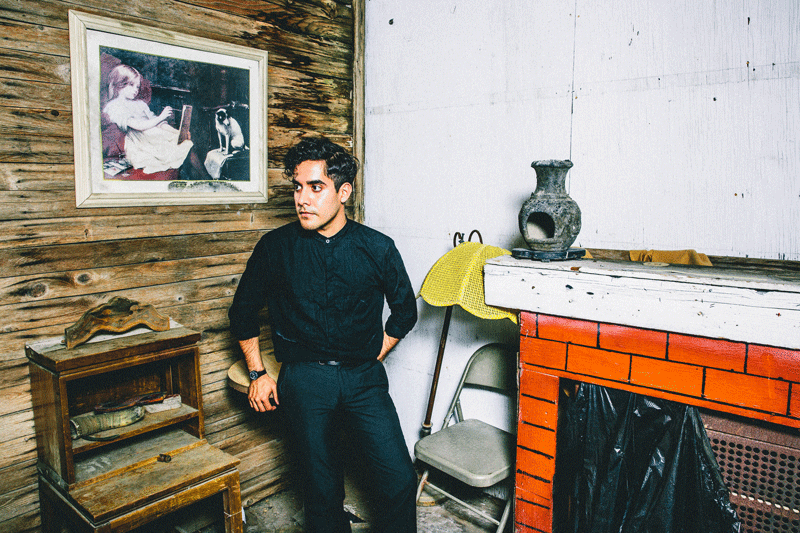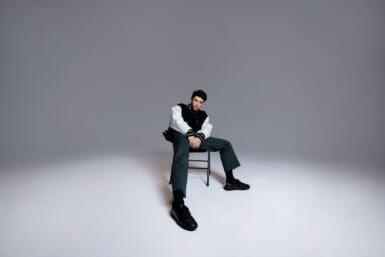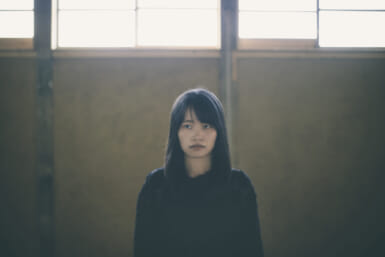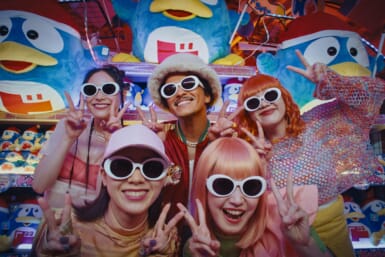Alan Palomo wasn’t just looking to direct a music video for his band’s recent single — he wanted to vividly capture a discotheque slaughter.
By Kyle Mullin
Pleasure and pain, bullets and sleazy leather outfits, blood-splatter and throbbing neon lights all converge in the gory stylized clip for “Slumlord,” a key track from “VEGA INTL. Night School,” the recently released third LP from fledgling synthpop outfit Neon Indian that is fronted by Palomo. And while the Denton, Texas–born artist is best known for masterminding the flaring incandescent tone of Neon Indian’s synth-heavy tunes, he hopes that the new music video will also herald his arrival as a cinematic auteur. But despite fans and critics’ enthusiastic response to the clip, Palomo confesses that his seemingly assured directorial breakthrough was by no means easy to shoot.
“Getting people to show up in that really drama punk, 80s goth fashion sensibly is a difficult thing to manufacture. It’s challenging to do that with wardrobe, you have to just find people who have that in their repertoire,” Palomo tells Weekender of the weirdo retro outfits that the actors wore for the video that he he co-directed with friend Tim Nackashi, which they called “Slumlord Rising,” because its eight minute running time has an extensive plot beyond the song’s five minute length. Palomo goes on to add that aside from Nackashi’s work behind the camera, another friend proved equally indispensable on set. “I reached out to my buddy Marcus, who plays one of the gang members, the Electronic Murderers, in the video. I told him about the kind of 80s wardrobe I wanted for the video and how difficult that would be to find, and I remember him telling me: ‘If you put me in this video I will bring 25 of the strangest goths you’ve ever met, they’ll all be awesome and perfect for your video.’ I said: ‘Yes, let’s do it.’ So we basically threw a goth party on set, and it was one of the best nights of my life.”
Below, Palomo tells us why his melding of film and music is long overdue, how shooting “Slumlord Rising,” has elevated Neon Indian’s live performances (like its gig slated for this evening at Tokyo’s Daikanyama UNIT), why Japan’s vibrant capital perfectly matches the band’s sensibilities, and more.
Aside from the wardrobe, what other challenges lay in shooting “Slumlord Rising”?
We only had the location for one night, so it was challenging to do these fairly elaborate shots in a short time. It was an old disco club, and we were the last thing that shot there before they gutted it on the inside and changed it for the new owners. But it was cool to capture, for posterity’s sake, what that place was like. The walls were littered with neon and it was just a very surreal space.
By “elaborate shots” do you mean the extended single take at the beginning?
Exactly. That opening shot was six minutes long. That alone ate up most of the evening, between the choreography of it and running through takes again and again, and trying to make sure everyone was hitting their cues at the same time, and getting some great performances as well. So that alone was a hell of an undertaking.
I’d directed some animated shorts with my friends in the past, but this was definitely the most ambitious video I’d ever made. There were a lot of moving parts involved in playing with a venue of that size (the old disco club). And the turnaround time was pretty quick. We shot it at the beginning of that month (October) and knew that, in less than a week, we had to put it out there to coincide with the album (“VEGA INTL. Night School,” which was released on October 16).
Tim Nackashi is a highly regarded music video director, having shot clips for Death Cab for Cutie, TV On the Radio, OK Go and others. Tell us more about directing the video with him.
Tim and I speak the same language when it comes to our visual sensibilities. We’d worked together before on the “Polish Girl” music video (from Neon Indian’s 2011 release, “Era Extraña”) and had great results.
You went to film school before Neon Indian hit it big. How does it feel to be bringing the two disciplines together?
It’s great. But they’ve always been connected in a way. My music was actually birthed from the frustration I had with my film program, which wouldn’t even let you touch a camera until your third year. So my immediate means of having some way to create something, to express myself, whatever you want to call it, was tinkering around with music.
Has film had any more recent impacts on your music? Did directing with Tim inspire you to write more visual lyrics, or did it affect your songwriting for a follow up to “VEGA INTL. Night School”?
I’ve got some ideas in my head. But I have no immediate plans to write another Neon Indian record. I’m not trying to be dramatic by saying this could be the last one, but it could be. It ultimately depends on if and when an idea for another record comes. There’s a few things I’m kicking around in my mind, but it’s sort of intermingled with these other things I’ve been wanting to work on. Like film, for instance. Ideally, I’d like to direct a feature-length movie of my own someday. That’s one takeaway from film school that I’d want to eventually accomplish.
If “VEGA INTL.” is Neon Indian’s last album, would it be like ending on a high note? Do you feel that it’s Neon Indian’s most accomplished LP yet? Are there a lot of signs of growth on it compared to 2011’s “Era Extraña”?
“VEGA INTL.” did take my entire bag of tricks to pull off. And I couldn’t be happier with the result. I would definitely say there was quite a bit of growth that happened just by design. I’d focus on stuff I wasn’t good at and try to do it well, and for anything I couldn’t accomplish I’d bring in someone with a specialized skill set to help me take it there. I learned a lot. Probably more than our first two records combined. That’s part of why it took four years to make.
What did you learn specifically?
It’s all in the production. I could talk for a long time about the model of compressor I learned to use and all the other technical things, but it would be a little taxing to get into that right now. Basically it’s about being studio literate – focusing more on songwriting and composition. I’d never really looked at songwriting in that way. I focused less on the palates, textures, and production style and really just made sure that there’s a real core there, a heart that you can feel.
How have your live shows grown along with the records?
It’s had a few permutations over the years. At first we just used projected visuals onstage while we played. But since then we’ve tried to do a lot more. A few friends have helped us use modular video synthesizers and even Xbox Kinect, so that we can influence the visuals with our actual physicality, and what we’re doing while we’re moving and performing. These devices are spit out bizarre visuals to coincide directly with us moving around and playing. I want there to be a symbiotic relationship between the things that are happening visually and musically, rather than them being two different things lumped together.
So that gives us an idea of what to expect from your Tokyo gig. On the flipside, what are you looking forward to most about coming here to perform?
I think if Neon Indian was a city, it would totally be Tokyo. It’s a really vibrant town, I love spending time there. Every time I go I make sure I’m there for at least a week. I love everything about it – from its near-futurism, to a lot of the music that comes out of there. I’ve been avidly following a lot of Japanese stuff from the late 70s and 80s. I’m a huge Yellow Magic Orchestra fan, and I also love a lot of what they produced, like the albums they did with Akiko Yano. There are a lot of things I love about Japanese culture in general, and Tokyo’s always a special time whenever I’m there.
Neon Indian will perform tonight at Daikanyama UNIT at 19:00. Tickets are ¥5,000. For more information, visit http://smash-jpn.com/live/?id=2375 or http://neonindian.com.









